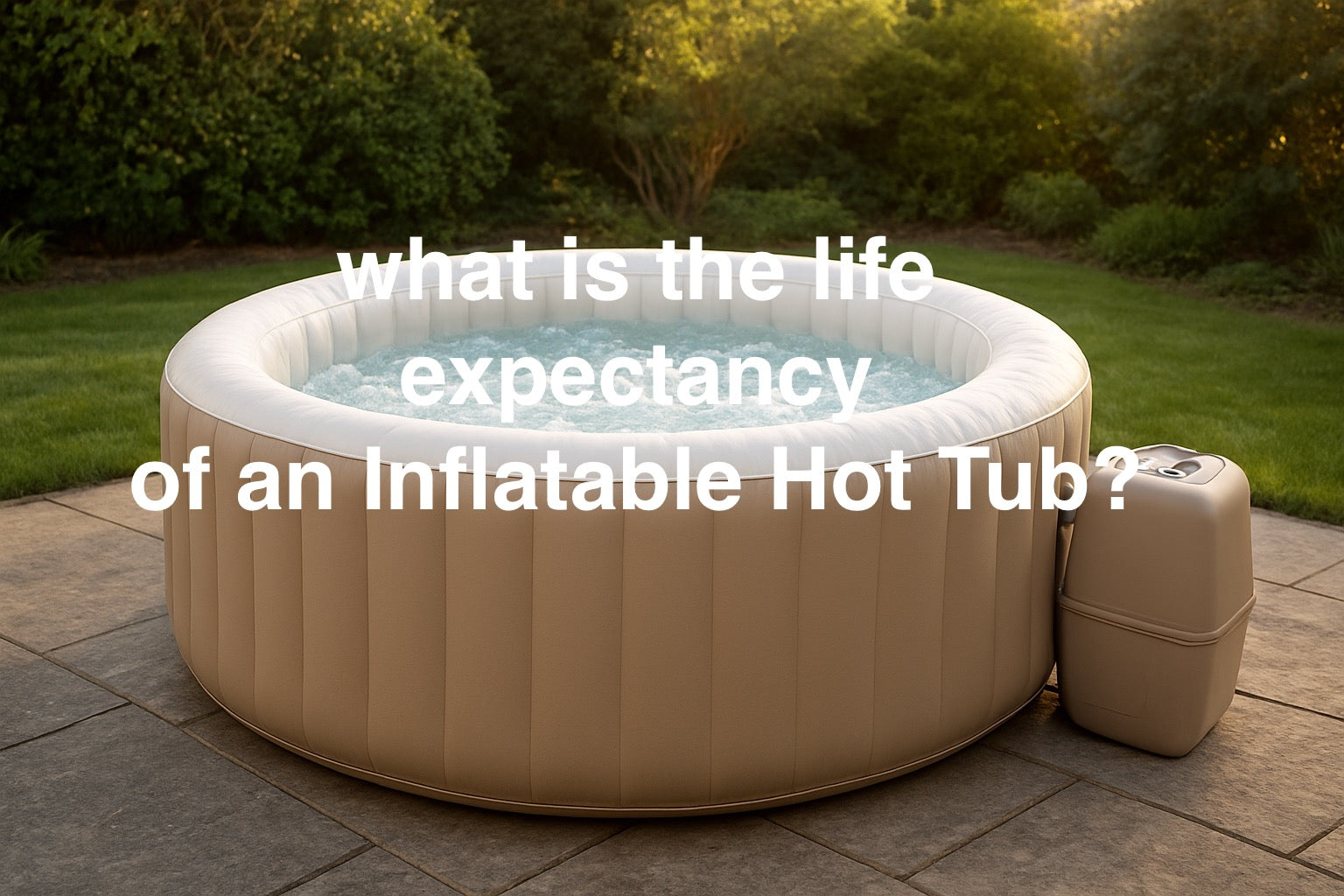
What is the life expectancy of an Inflatable Hot Tub?
Inflatable spas are brilliant fun—but how long do they actually last before fizzling out? Short answer: anywhere from 2 to 5 years, depending on care and quality. Stick with us and we’ll share the sneaky culprits that cut their life short and the simple tricks to keep yours bubbling longer.

The Average Lifespan: What to Expect
The Typical Range (2–5 Years)
For most families, an inflatable hot tub will see you through 2–3 summers if it’s an entry-level model. Spend a little more on a sturdier version, and you might stretch it to around 5 years.
That’s plenty of family soak sessions, but it’s not forever.
How Proper Care Can Extend Life (Up to 7–10 Years or More)
Here’s the good news: with proper care, we’ve seen families keep theirs running for as long as 7–10 years. Regular cleaning, correct chemical balance, and safe storage really do make a difference.
Think of it like keeping a family car going—skip the servicing, and it won’t last long. But keep on top of the basics, and it surprises you.
Comparison to Traditional, Hard-Shell Hot Tubs (10–20+ Years)
Of course, inflatable spas can’t quite compete with hard-shell hot tubs. Those can last a decade or two if cared for properly.
So if you’re hoping for something that grows up with the kids, a permanent tub might be the smarter long-term choice.
Key Factors That Affect an Inflatable Hot Tub’s Lifespan
Quality of the Hot Tub Itself
Material Quality (PVC, Reinforced Vinyl)
Not all inflatable tubs are made equal. Budget ones often use thinner PVC, which feels fine at first but wears quickly.
Premium models usually have reinforced vinyl or triple-layer walls. They’re sturdier, hold their shape better, and cope with more enthusiastic splashing.
Build and Brand Reputation
It’s a bit like pushchairs—you get what you pay for. Trusted brands often spend more on durable pumps, stronger seams, and better safety checks.
That extra investment usually shows in how long the tub actually lasts.
Warranty Length and What It Covers
Warranties tell you a lot about confidence in a product. Some inflatables only come with 12 months’ cover, while others offer longer on pumps and heaters.
If a brand is happy to back their spa with a solid warranty, it’s usually a good sign.
Frequency and Intensity of Use

Seasonal vs. Year-Round Use
An inflatable hot tub that only sees summer use will last longer than one battling British winters. Rain, frost, and constant heating all shorten its life.
Number of Users
The more people piling in, the more wear and tear. A couple using it occasionally will get more years than a family of five jumping in daily.
Impact of Daily Use on Wear and Tear
Daily soaks are tempting, but they do push the spa harder. Constant heating and cooling puts extra strain on pumps, seams, and liners.
Maintenance and Care
Water Chemistry and Cleaning
Here’s where most inflatable hot tubs fail. Poorly balanced water eats away at the liner and pump.
Check pH and sanitiser levels regularly—it’s the difference between crystal-clear family fun and murky water that shortens your spa’s life.
Filter Maintenance and Replacement
A clogged filter means the pump has to work twice as hard. Replace them every few weeks, depending on use.
Think of it like hoovering—skip it too often, and things start to go downhill.
Proper Draining, Cleaning, and Storage
When it’s time to pack it away, draining and drying it fully is a must. Damp material can lead to mould and mildew that ruins the spa.
Winterising properly is one of the easiest ways to add years to its life.
Protecting from the Elements
A cover isn’t just about keeping leaves out. It helps with heat loss, UV protection, and even stops curious cats from testing their claws on it.
Making Your Inflatable Hot Tub Last Longer

Choosing the Right Location and Setup
Level Ground and Proper Foundation
Placing it on solid, level ground spreads the weight evenly. This stops seams from straining and makes the whole tub more stable.
Avoiding Sharp Objects and Rough Surfaces
A protective mat underneath is a game-changer. It stops punctures from gravel, decking splinters, or anything lurking in the grass.
Establishing a Routine Maintenance Schedule
Daily/Weekly Checks
Quick five-minute checks keep things running smoothly. Test pH, chlorine, and sanitiser levels before use.
Monthly Cleaning Tasks
Wipe down the sides and rinse filters once a month. It keeps things fresh and prevents grime building up.
Quarterly or Bi-Annual Deep Cleaning and Water Changes
A full drain and clean every few months resets everything. Fresh water makes the spa feel brand new again.
Smart Usage Habits
Showering Before Use to Reduce Contaminants
Getting the kids to rinse off first might feel like herding cats, but it works. Less soap, oils, and dirt in the water = a longer-lasting spa.
Using the Cover When Not in Use
It’s such a simple habit, but one that saves so much hassle. Covers protect against debris, weather, and even wandering wildlife.
Avoiding Misuse or Overloading the Tub
It’s tempting to cram in “just one more person”—but overloading weakens seams and overworks pumps. Stick to the recommended capacity.
Dealing with Common Issues
Patching Leaks and Punctures
Most leaks can be fixed with repair kits. Spotting them early makes all the difference, so check regularly for tiny drips or air loss.
Troubleshooting Pump and Heater Issues
Weird noises, weak jets, or slow heating are signs something’s not right. Catch problems early and you’ll often save yourself a bigger repair bill later.
Final Thoughts: Making the Most of Your Inflatable Spa
Inflatable hot tubs are a brilliant entry point into garden spa life. They’re fun, affordable, and give families hours of bubbly memories.
But like anything inflatable, they do have limits. With the right care, you could enjoy yours for years. Neglect it, and you might be back shopping for a replacement far sooner.
If you’re looking for long-term luxury, a hard-shell spa is the better investment. But for budget-friendly fun and a taste of hot tub life? An inflatable spa does the job nicely.
Have you checked out our other posts?
What Are The Downsides Of Inflatable Hot Tubs?
What Are The Negatives Of Inflatable Hot Tubs?
Do You Sit On The Floor With An Inflatable Hot Tub?
How Long Do Inflatable Hot Tubs Usually Last?
Do Inflatable Hot Tubs Puncture Easily?
How Often Should I Change My Inflatable Hot Tub Filter?
What Is The Best Thing To Clean The Inside Of An Inflatable Hot Tub?
Are Inflatable Hot Tubs A Lot Of Maintenance?
Should You Leave An Inflatable Hot Tub On All The Time?
Are Inflatable Hot Tubs Durable?



Leave a comment